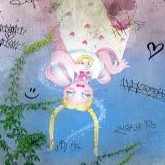From 8 May 2021, Jupiter Artland Foundation will unveil upside mimi ᴉɯᴉɯ uʍop (pronounced Upside Down Mimi) a new permanent outdoor installation by Scottish artist Rachel Maclean, alongside a solo exhibition featuring four key works from the last decade of her career. Three years in the making, this ground-breaking new commission is the first time Maclean has working entirely with cartoon animation and at an architectural scale, and her ultimate ambition is to transport Mimi’s world to high streets around the UK.
Known for her satirical characters and meticulously crafted fantasy worlds, Rachel Maclean has rapidly established herself as one of the most distinctive creative voices in the UK. Based in Glasgow, Rachel Maclean graduated from Edinburgh College of Art in 2009 and her work came to public attention in New Contemporaries later that year. In 2017, she represented Scotland at the 57th Venice Bienniale.
Combining animation and architecture, upside mimi ᴉɯᴉɯ uʍop takes the form of an abandoned high-street shop, sited within the woodland at Jupiter Artland. Responding to an invitation from Jupiter, Maclean has taken her inspiration from commercial spaces as sites of desire, combining this with the role forests play within fairy tales, being at once places of magic, of danger, of transformation and where the normal rules of daily life no longer apply. At the end of a woodland path, a toy shop – seemingly abandoned and derelict on the outside – will, on entering, reveal itself to be the upside-down world of cartoon princess Mimi. Maclean’s first fully animated heroine, Mimi is a darkly arch character for our generation who invites us into the topsy-turvy world of end-game capitalism; a 21st century fairy-tale about the experiences of young adults and consumerist desire.
Created in dialogue with teenagers from across Scotland recruited by Jupiter Artland, Rachel Maclean’s new commission responds to the pressures facing young people in the shadow of the pandemic, the rise of online culture and the decline of real-life spaces on our highstreets, town centres and countryside as sites for young people to express, define and discover their own identities. A public programme will accompany the commission exploring these themes and there are plans to create a moveable iteration of the installation to tour across highstreets nationally.

Alongside the new commission Jupiter Artland will invite audiences to delve further into the imagination of Rachel Maclean through the display of four seminal works made during the last decade. Visitors can watch in full her 2017 Venice Biennale commission Spite Your Face, a post-truth dystopian tale inspired by the divisive campaigns currently dominating global politics. As a rare treat, audiences can see one of Maclean’s earliest artworks, The Lion and the Unicorn, 2012, an inspired commentary on Scottish independence and the crisis of the union. Emblazoned with Union Jacks and Solitaire flags, Maclean dresses as a lion to embody English voices and a unicorn for Scottish ones, borrowing the vocal talents of Jeremy Paxman and Alex Salmond to excellent comic effect. Firmly in the tradition of the greatest political satire, Maclean’s work has a timeless quality, reinforcing the message that although faces change and headlines shift, the farce of political life and comic-tragedy of human frailty is endless and forever.
Lesser known to gallery audiences are Germs, 2013, and Eyes To Me, 2015, two shorter works created in the vein of info-commercials and kids TV. Timely to revisit in this era of hand-sanitising and social distancing, Germs follows a glamourous female in her battle against an adorable army of pink-and-purple germs, each played by the artist. Rather more unsettling is Eyes To Me, made in the style of a children’s television programme, where a young protagonist named Sophie moves through an enchanted garden inhabited by a race of cuddly Cyclopes. As the video shifts between different formats (kids TV, a fashion shoot, a probing interview), Sophie is surveyed, coerced and reprimanded by an omnipresent male voiceover, whose treatment of her moves from benign paternal care to cold, militant disapproval.
Using colourful make-up and extravagant self-designed costumes, Rachel Maclean plays all the characters in the films herself, borrowing from fairy tales, children’s television, product advertising, and internet pop videos. Employing computer technology to generate her locations and appropriating voices from popular television, the internet, and cartoons, Maclean deftly constructs super-saturated, cinematic alter-worlds populated by cautiously psychotic characters.










